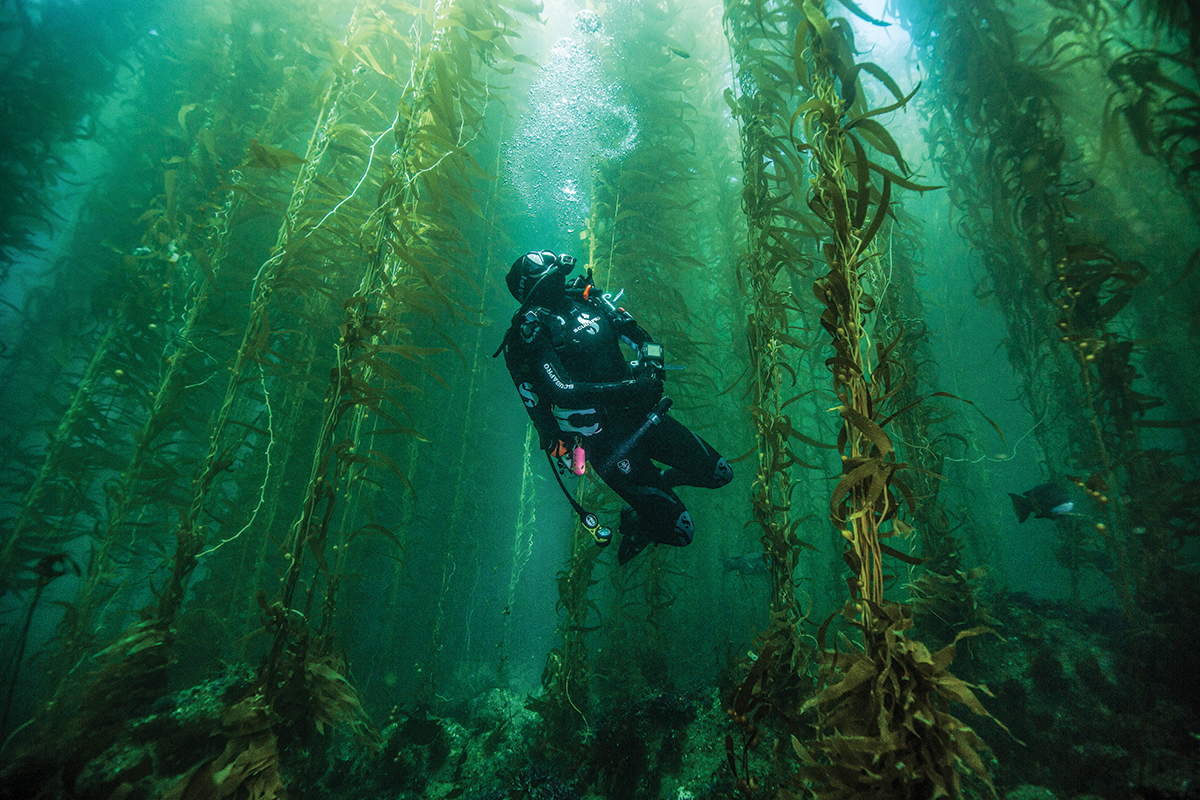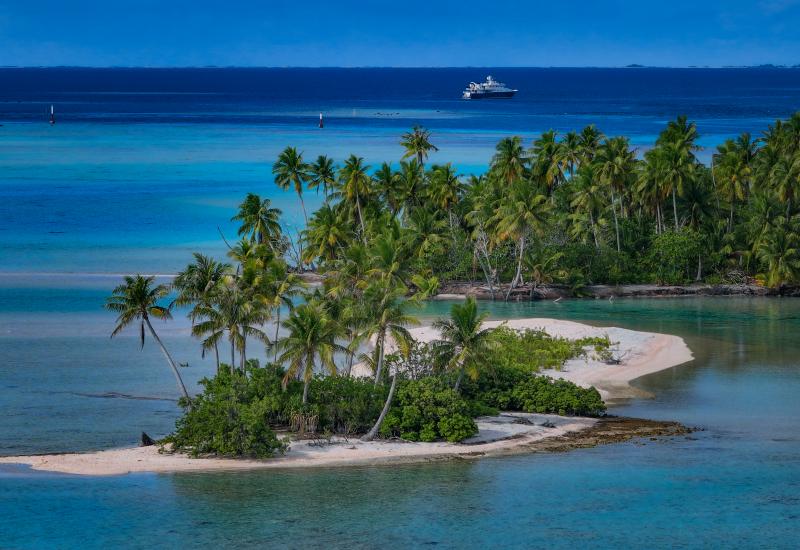Seven National Parks with Great Scuba Diving
Looking for great diving here in the good ol’ US-of-A? Then National Parks should be on your radar! Everyone can see Old Faithful and the Redwoods, but only divers can explore millions of acres of submerged parkland.
Glacier National Park

Shutterstock.com/Benny MartyExplore elevated diving along the Canadian border.
Location
The park straddles the Canada-U.S. border between Montana and Alberta; both Lake McDonald and Saint Mary Lake are open to divers.
When to Go
The park is open year-round, though facilities can close in severe winter weather. April to November is best for diving, with midsummer water temps ranging from 60 degrees at the surface down to about 40 degrees at 100 feet.
Dive Shop
Flathead Scuba is a dive shop about half-an-hour from the park’s main dive site, Lake McDonald.
Experience
Intermediate to advanced skills; must have experience in altitude and frigid-water diving—Lake McDonald is more than 3,100 feet above sea level. The cold water temperatures generally provide good viz.
Stay
There are campgrounds throughout the park, with three (Fish Creek, Apgar, and Sprague Creek) near Lake McDonald that cost between $20 to $23 a night.
Discover
Divers can explore underwater trees about 50-feet below the north end Lake McDonald. The south end of the lake, easily accessible from the Apgar visitor center, offers old docks, tools and a small boat on the sound end. A shallow wreck known as Fish Creek Bay Wreck rests at max ten feet deep in Fish Creek, near the southern end of Lake McDonald.
Get ready to dive Glacier National Park with PADI’s Altitude Diver and Drysuit Diver courses.
Channel Islands National Park

Shutterstock.com/Bram ReusenWho doesn't want to dive in the Pacific Ocean with playful sea lions and harbor seals?
Location
The park covers five islands off the southern California coast by Santa Barbara: Anacapa, Santa Cruz, San Miguel, Santa Barbara and Santa Rosa.
When to Go
Channel Islands National Park is open year-round; many consider the fall to be ideal because temperatures reach 70 degrees F and visibility averages 100 feet.
Dive Shop
Book a Channel Islands liveaboard with Horizon Charters, or a day excursion with shops like Cal Boat Diving or Channel Islands Dive Adventures.
Experience
Due to windy conditions on Santa Rosa and San Miguel, currents can be unpredictably strong, so divers need to be experienced and properly trained, conditioned and equipped. Wetsuits and hoods are recommended during colder months, when the water temperature ranges from 55 to 70 degrees F.
Stay
There is one campground on each of the five islands. Reservations are required and cost $15 a night. Conditions are rustic—fires are not permitted, campers must take their trash with them off the island, and Santa Rosa and Santa Cruz Islands are the only two sites that have water.
Discover
Divers can explore kelp forests, coves, caves and more throughout the islands. Painted Cave stretches nearly 1,300 feet long and 100 feet wide along the northwest coastline of Santa Cruz. Dive Landing Cove off Santa Barbara to find sea stars, spiny sea urchins, orange garibaldi, playful sea lions and harbor seals.
Dry Tortugas National Park

Shutterstock.com/Mia2YouDive tech-wrecks, coral, and with sea turtles at this park south of the Florida Keys.
Location
Spanning 100 square miles and seven small islands, this remote national park is roughly 70 miles from Key West and is accessible only via boat or seaplane.
When To Go
Open year-round, including holidays; for best conditions, go between May and September to avoid thunderstorms. Water temperatures range from 87 degrees F in summer to 68 degrees F in winter, and visibility ranges from 40 to 100 feet depending on the conditions.
Dive shop
Adventure Watersport Charters, based in Key West, offers diving liveaboard charters from two days and two nights to four days and four nights.
Experience
The Dry Tortugas offers dive sites suited for all levels. The inner (3- to 30-feet deep) and outer (35- to 80-feet deep) reefs teem with coral and marine life — and have excellent natural light, good for underwater photographers.
Stay
Camping on Garden Key in Dry Tortugas National Park costs $15 for an individual campground, which can accommodate up to six people, or $30 for a group campground. Reservations are not required for individual campsites. Plan ahead when it comes to transportation—the commercial ferry to and from Garden Key only takes ten campers each way per day. Private boats are permitted, but can only anchor in sandy or rocky areas within one nautical mile of the Fort Jefferson Harbor Light.
Discover
Divers can encounter sea turtles, nurse and bull sharks, eels, friendly goliath grouper, and an abundance of lobsters. It’s also a wreck-diving hot spot, from the iconic—and rec-friendly—Windjammer to tec-wrecks Araby Maid and M/S Rhein Hamburg.
Kenai Fjords National Park

Shutterstock.com/TroutnutSea lions and orcas await the diver who overcomes the difficulty of getting gear to the remote Alaskan wilderness.
Location
This park in Alaska covers more than 1,000 square miles.
When To Go
May through August.
Dive Shop
Dive Alaska is a full-service dive center based in Anchorage with boat charters into Resurrection Bay.
Experience
This site is for intermediate to advanced divers ready to handle visibility that can swing from poor to excellent. Additional challenges include frigid ocean currents and no local diving businesses, but the rewards include stunning marine life.
According to the National Park Service (NPS), this park is logistically “extremely challenging” for divers. The closest dive shops—including sites for air fills—are in Anchorage, over 120 miles away. Divers are responsible for getting all of their gear to the park, “which needs to include a compressor,” according to NPS. Charter boats in the nearby town of Seward can take you diving in the park.
Stay
Exit Glacier, a campground in the park, has 12 spots given away at a first come, first serve basis. It often fills up in July and August. Nearby Chugach National Forest also has several campsites, which range from $10 for a single site to $150 for a group site.
Discover
Get ready for big sea life encounters! Sea lions, orcas, grey or humpback whales, sea otters and sea bass all rove the fjord. NPS even claims there is halibut “the size of a barn door” romping around.
Acadia National Park

Shutterstock.com/Eric UrquhartWant to dive the east coast’s only fjord? Head to Maine.
Location
The Maine park sprawls across portions of several islands scattered just off the coast, including Mount Desert Island and Isle Au Haut.
When To Go
Mid-July is the prime time.
Dive Shop
Johnson's Sporting Goods-Rockland, about two hours away, is among the closest dive shops.
Experience
Intermediate to advanced divers will find limited shore diving and copious boat diving in cold water conditions. Divers will have to contend with tidal currents and poor to moderate visibility ranging from 10 to 30 feet. NPS recommends a portable compressor for divers leaving Mount Desert Island.
Stay
There are three campgrounds across the park islands, and five lean-tos on Isle au Haut. Prices range from $22 for an individual tent site to $60 for a group site.
Discover
Try a shore dive in the Somes Sound, the east coast’s only fjord, or scan for famous Maine lobster at sites like the Seawall and Otter Point.
Yellowstone National Park

Shutterstock.com/WelcomiaAltitude divers can float with thermal columns and a 125-foot sunken steamer.
Location
Largely in Wyoming, parts of this park stretch into Montana and Idaho.
When To Go
July and August.
Dive Shop
Based in Jackson, Teton Aquatic has a 42-year history of diving lakes and rivers throughout the region.
Experience
Diving in Yellowstone is for intermediate to advanced divers trained for altitude diving and cold water; visibility is poor to moderate, ranging from 10 to 30 feet. The main dive site, Yellowstone Lake, is among the world’s largest altitude lake dives, covering 125 square miles more than 7,700 feet above sea level. Shore dives are the norm.
Stay
There are 12 campgrounds in the park, five of which require reservations ahead of time. Tent campsites range from $15 to $32 a night. Grant Village and Bridge Bay campgrounds are the closest sites to Yellowstone Lake.
Discover
Thermal columns fizz visibly upward in Mary Bay at the northeastern corner of Yellowstone Lake, giving divers the chance to hover in a steady stream of warm bubbles that cause visual distortions. The E. C. Waters, a 125-foot steamer, sits just eight feet below the surface of the lake.
Exercise caution diving in the West Thumb Geyser Basin—NPS warns the thermal vents have uneven water temperatures, water can be cold in one section but dangerously hot nearby.
Get ready to dive Yellowstone National Park with PADI’s Altitude Diver and Drysuit Diver courses.
Olympic National Park

Shutterstock.com/Galyna AndrushkoDivers can choose from salt or freshwater diving in northwestern Washington.
Location
The shore of northwestern Washington.
When To Go
June to October.
Dive Shop
Port Angeles-based Strait Scuba is a full-service dive center leading guided dive excursions throughout the North Olympic Peninsula coast.
Experience
Intermediate to advanced divers should stay vigilant for tidal currents, surge, rocks and loose logs. Water will be cold whether diving in the ocean or inland. Most dives begin from shore.
Stay
Pick from 14 campgrounds within the park, only three of which accept summer reservations. The rest are walk-in only. Prices range from $15 to $24 a night, sites are limited to eight people.
Discover
Skim along with sizable white-and pink-plumed anemones in Hood Canal, a 70-mile long inland extension of the Pacific Ocean. For freshwater diving, head to Lake Crescent—you can find a barge at 25 feet in pristine water that offers visibility up to 150 feet. Just outside the national park is Salt Creek State Park, where divers can explore a wreck called the Diamond Knot sits in 80- to 140-feet of water or a kelp bed teaming with marine life.
DIVE DEEPER: For more information about diving in national parks, head to NPS.gov/Submerged.
Related:











